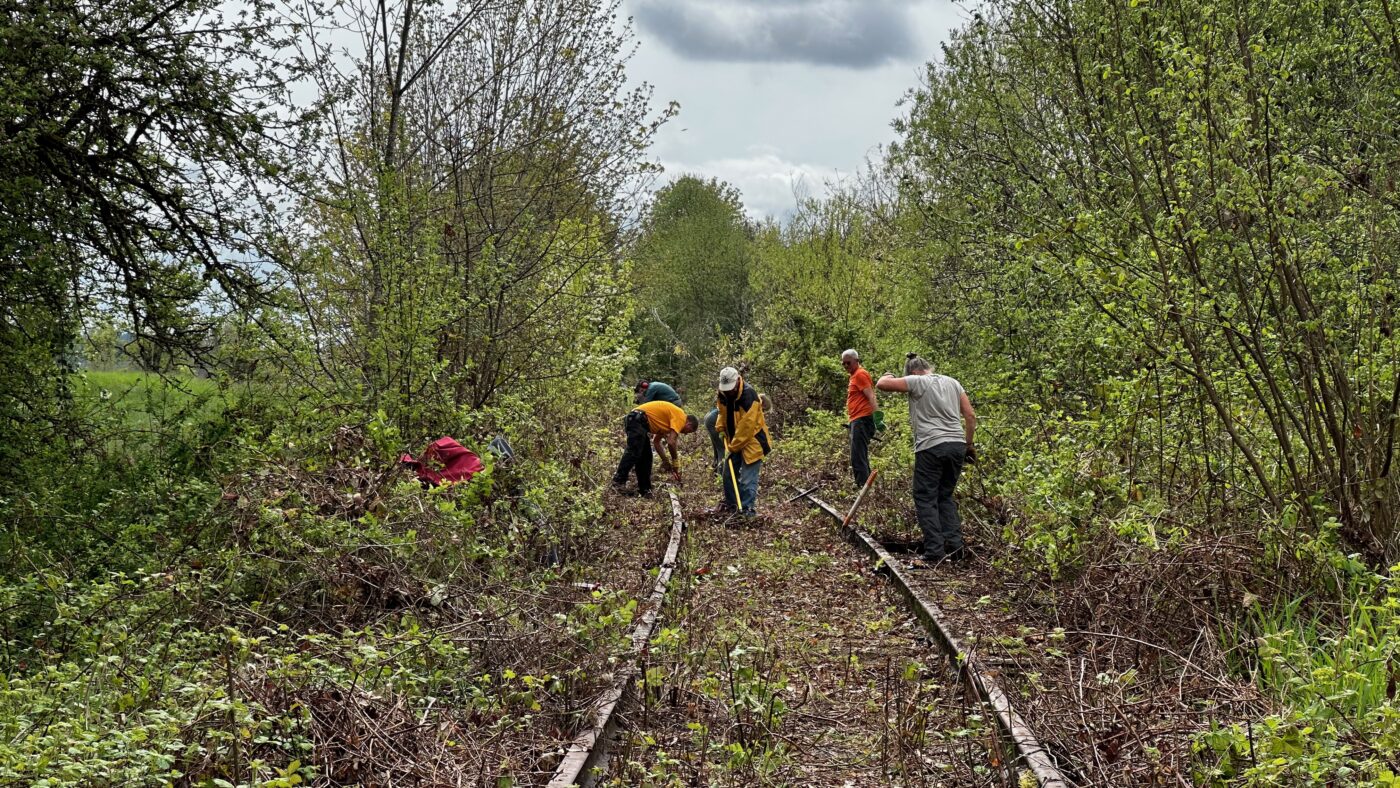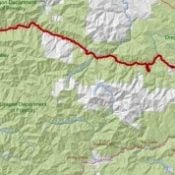Caroline Fitchett calls the Salmonberry Trail “Oregon’s next big adventure” and considers it the most ambitious rail-to-trail project in the nation. Fitchett is executive director of the Salmonberry Trail Foundation, the nonprofit that’s leading a coalition of government agencies in development of an 82-mile trail that would connect Washington County to the city of Tillamook on the Oregon Coast.
Imagine biking or hiking through wild river valleys and across abandoned timber settlements along a historic railroad line.
I first wrote about the project 11 years ago and it has captured my imagination ever since. Now more than a decade into the planning process, the project has matured nicely. In the past year or so, volunteers have begun to rip out the old railroad tracks, cut back ivy and blackberries, and parts of the trail are even open for guided hikes. This past summer, US Congresswoman Suzanne Bonamici hiked the trail and Fitchett says visits from Senators Ron Wyden and Jeff Merkley will happen this year.
In my interview with Fitchett, she shares the story about how the project first came about. I had no idea it began with one mom and dad in Tillamook who just wanted a safe place for their kids to ride bikes! We also talk about a few current projects in Rockaway Beach, Tillamook, and Buxton (north of Banks) that will result in the first official pieces of the Salmonberry that will be open for riding and hiking.





One notable moment in this interview is when I asked Fitchett how she talks about the trail in front of communities who might have some inherent skepticism about it. “I really let them talk about it,” she replied. “We listen… we also share information so they know what our plans are and they have a chance to change those plans.” Fitchett she sees the trail as a neighbor to the communities along it. “We are a neighbor to hundreds of people, to school districts, to watersheds, to the fish and the birds that are along the trail. And so we have to do the best we can to be a good neighbor.”
One ace up the Salmonberry’s sleeve is that all the land needed for the trail is already banked and dedicated to this use. So that saves the organization from having to acquire any rights or easements. “The only thing in our way is planning it appropriately… and raising the money to build it — and figuring out how to maintain it.”
“Only” is doing a lot of work in that sentence for sure. But with the massive political support behind this project and its obvious benefits to Oregon, hopefully we can shorten the estimated timeframes.
When I asked Fitchett the classic “When will this thing be done?” question, she admitted she doesn’t have a good answer. “I tend to say either between 20 and 50 years, or as soon as we have raised the first $50 million I’ll have a very clear answer for you.”
So that’s our marching orders straight from the top, folks. Help the Salmonberry Trail Foundation raise its first $50 million through the federal RAISE grant they plan to apply for in the coming weeks. Stay tuned to SalmonberryTrail.org to get involved, support the grant, sign up for guided hikes, and more.
— Watch my interview with Fitchett above or on our new page, BikePortland.org/YouTube. I’ve also uploaded this interview as a podcast episode that you can listen to below or wherever you get your podcasts.




Thanks for reading.
BikePortland has served this community with independent community journalism since 2005. We rely on subscriptions from readers like you to survive. Your financial support is vital in keeping this valuable resource alive and well.
Please subscribe today to strengthen and expand our work.
I walked 16 miles of the railroad, before the big floods of 2007, when it was still (barely) a working railroad, and it was absolutely spectacular.
Building this trail will be a huge feat, esp the engineering through Salmonberry Canyon where the grade was washed away. But if it ever gets done – boy oh boy will it be one of the best rail-trails in the world!
This is why the north/south Yamhelas Westsider Trail by Highway 47 is great needed. That trail willl connect McMinnville to the Salmonberry and Banks Vernonia trails. Highway 47 has places with just a half foot shoulder on a busy and rural 55 mph highway.
I had the pleasure of riding the Great Allegheny Passage and C & O Canal Trail from Pittsburgh to Washington, DC back in 2010. About every 10-20 miles, the trail passes through a small town or village. All have B & B accommodations, a bike shop, restaurants, or small grocery stores. I rode with two other people and we spent money on lodging, food, drinks, tubes, etc. at nearly every town along the way.
Bike tourists would be a boon to these small communities along the Salmonberry Trail. They should not underestimate that hungry and tired cyclists don’t think twice about spending money for a hot meal, a cold beer, and a spare tube. As far as environmental concerns go, bike riders and hikers are far less intrusive and damaging than ATV and dirt bike riders. I hope that this gets built out before I become too old to enjoy it.
Yep! And I so hope that they place primitive hiker biker camp sites every 10 to 20 miles…and with bike repair stand and recycled telephone poles for tying up hammock tents (lower impact camping)
Maybe they can get a deal on second-hand illuminated hammock poles from Portland Parks.
And even closer, the John Wayne/Iron Horse trail has a similar (though less developed) experience. Easy grades on smooth gravel, riding through abandoned tunnels through mountains, and beautiful semi-primitive campsites, all starting a bit east of Seattle. AFAIK, there is very little pushback from adjacent land owners. These types of trail systems can be examples to those in opposition who fear the trail will become overrun by homeless campers etc.
Much of the trail looks to be squarely on public land in the Tillamook State Forest, which offers many recreational uses. I can envision coming across the trail while recreating so how is it that “if you go out there you are definitely trespassing” as Caroline says at 5:50? Is it only if you happen to step foot on the rail easement while you are otherwise lawfully recreating on public land? Would like to be pointed to the regulation preventing access or defining the trespass.
I wondered, too. The way I understood it, though, was that only parts of the trail were finished so the parts of the trail were open to the public…
Looks so nice. I moved to Portland recently and am looking positively at the outdoor activities including bike riding.
It sounds like a lot of money, but this trail could easily be built with the planning money we are spending to design our highway expansions. It would be nice to see a comparison on the financial rate of return between a rail trail and a highway expansion project.
It costs about $145,000,000 for the 217 freeway project which is paving over land in the Fanno Creek floodplain.
This was a great interview, thanks for sharing Jonathan. Just want to make a small clarification that it was the Yamhill County Board that killed the Yamhelis Trail, not Washington County.
I thought there is still a chance for the Yamhelas Westsider Trail to get built.
Man… 20-50 years is a punch in the gut.
yeah I really don’t like when folks say that kind of thing. I wish they’d have a better answer that was still true and accurate, but not so demoralizing! I love how Dan Kaufman talked about a trail idea he had for the Oregon Coast. He’d always scoff at the long timeframes and be like, “Ask them how long it took to build Hwy 101!” I agree.
This is such a great project- thanks for helping to promote it. With enough excitement, this COULD get built a lot faster. Maybe unlikely, but a guy can dream!
So 25 to 50 years. Why would many want to donate to a trail that many donors either won’t be alive to enjoy or who will be too old to enjoy?
I agree! That’s a great reason why I think it’s a huge mistake for anyone around these projects (gov’t staff or advocates) to say stuff like that. The best answer, which Caroline also gave, is, “It can be done as fast as we can raise the money and get the trucks out there!” It has always baffled me how supporters of something fall into the trap of implicit support of terrible timelines.
I have hiked much of the closed sections of the trail and they are extremely rough and very secluded. Think failing tunnels, bridges gone etc.
Personally I don’t think a traditional rail trail in the middle is realistic. Why not put in a dirt singletrack that parallels the river in the middle section? It would be like an amazing version on the Wilson River Trail without the road noise. It could be built largely by volunteers and would be much easier to reroute when and if the next slide/ floods happen. The cost would be minimal in comparison Trying to get a rail trail down that section in and maintained really becomes clearly a bad idea when you see it first hand. I feel that most of the people pushing it have never even seen the terrain.
Thank you so much, Jonathan, for highlighting the Salmonberry Trail — ‘Oregon’s Next Big Adventure’!